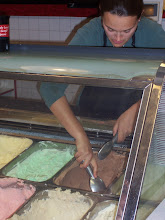Speech

Some people have been asking to see the speech I co-wrote for graduation, but I don't have a copy of it... I have sent out an email to my classmates to see if anyone has it recorded. In the meantime, here is a picture and a rough copy of what was said. The parts in green are the ones I said and the black ones are Logan's lines.
If you are wondering why Logan looks so familiar, it's because you have seen him before - he was the DJ for our wedding. Not that anyone danced because it was 100+ degrees, but he was there nonetheless.
Before we get started with our speech, we have been asked to read the following public service announcement:
“The Department of Occupational Therapy at
We’d like to begin our remarks by thanking David for his performance and all faculty and staff for their support and guidance, and for remarkably, allowing us to graduate today. It has been a tradition that the graduating class presents the department with a gift. At this time, we would like to ask Karen Spencer to come up and accept this birdbath and bulbs that will bloom every year around graduation time on behalf of the department. Thank you all so much!!
When we were asked by our classmates to speak today ___ & I knew which points we wanted to make, but were unsure of the format through which to address them. Then, we remembered something that we’ve heard over and over and over again since we first arrived here at CSU nearly two years ago: when in doubt, always return to the Practice Framework. For those of you who have not had the great privilege of being familiar with this document, it is intended to outline the process of OT evaluation and intervention.
That being said, any good soon-to-be practitioner should know by now that the first step is evaluation. Evaluation was a two way street in our case: we evaluated our own lives, professional and personal goals and came to the conclusion that we would like to serve others through the profession of occupational therapy. Likewise, we were evaluated by this highly regarded competitive program and deemed worthy of making the final cut. It was the product of this evaluation that brought us all together.
Following an evaluation, it is necessary to develop an occupational profile – which describes a person’s experiences, interests, patterns of daily life and values. To create a collective occupational profile for our class we would have to include the variety of experiences that each person brought to our group.
Whether it be educational background, prior work history, geographical location or life stage each person brought a different dynamic. Out of 39 students we came from 19 different states: from
The next phase is to come up with an intervention and implement it. This began on orientation day when we made our first of many collages (and Logan and Mike realized that they represented the greatest diversity in the program). From that point on intervention included such things as countless hours in the computer lab (waiting for the printer), trips to New Belgium, weekends at Copper Mountain, reflecting with Karen Atler, reflecting with Karen Atler, wheelies in the wheelchair, more arts and crafts than I ever imagined dealing with, living through the magic finger moment, intramural sports (soccer champs!), sock aids, hikes up to horsetooth, an ugly sweater holiday party at school (and several costume parties outside of school).
As you can see, our areas of occupation ranged from Education, to Social Participation to basic activities of daily living – sometimes just rolling out of bed and making it on time to those early morning classes (we’re not gonna call anyone out- we all know who you are).
In the last two years, there is no doubt that we increased our performance skills, an important component of the practice framework. After all, nothing builds endurance like sitting through a three hour theory lecture! Communication skills were improved upon through practicing documentation, goal writing, and facebook chatting. Motor skills were finely tuned from ambulating out of the way of Whitney’s ever-present camera (at this point I took a few pictures of my classmates).
The final step in any intervention is to address the outcomes. Have we learned anything? We’ve learned how to feed each other, facilitate movements, to hand sew, make crepes, write goals, play the guitar (and guitar hero), use clinical reasoning, observe significance at a p value of .05, how to use adaptive equipment, and that our classmates will be our best professional resource. And so, before we are ‘discharged’ and sent into the professional world let us establish one final short and long term goal.
STG: By May of 2009 we will successfully complete our level 2 fieldworks with minimal verbal cues and stand-by assistance from family, friends and mentors.
LTG: We take to heart the new catch phrase of OT in both our personal and professional contexts that is to always…. Live life to its fullest.


0 Comments:
Post a Comment
<< Home